中职英语模块1Unit7全单元教案设计
- 格式:doc
- 大小:21.90 KB
- 文档页数:15

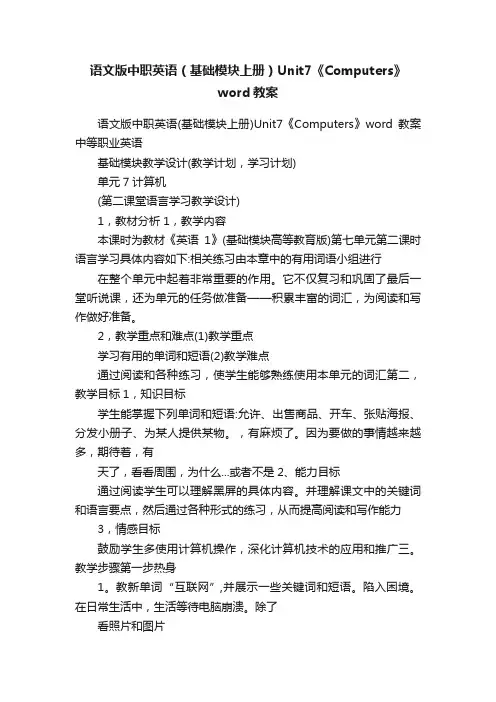
语文版中职英语(基础模块上册)Unit7《Computers》word教案语文版中职英语(基础模块上册)Unit7《Computers》word教案中等职业英语基础模块教学设计(教学计划,学习计划)单元7计算机(第二课堂语言学习教学设计)1,教材分析1,教学内容本课时为教材《英语1》(基础模块高等教育版)第七单元第二课时语言学习具体内容如下:相关练习由本章中的有用词语小组进行在整个单元中起着非常重要的作用。
它不仅复习和巩固了最后一堂听说课,还为单元的任务做准备——积累丰富的词汇,为阅读和写作做好准备。
2,教学重点和难点(1)教学重点学习有用的单词和短语(2)教学难点通过阅读和各种练习,使学生能够熟练使用本单元的词汇第二,教学目标1,知识目标学生能掌握下列单词和短语:允许、出售商品、开车、张贴海报、分发小册子、为某人提供某物。
,有麻烦了。
因为要做的事情越来越多,期待着,有天了,看看周围,为什么...或者不是2、能力目标通过阅读学生可以理解黑屏的具体内容。
并理解课文中的关键词和语言要点,然后通过各种形式的练习,从而提高阅读和写作能力3,情感目标鼓励学生多使用计算机操作,深化计算机技术的应用和推广三。
教学步骤第一步热身1。
教新单词“互联网”,并展示一些关键词和短语。
陷入困境。
在日常生活中,生活等待电脑崩溃。
除了看照片和图片1。
互联网做笔记!2.搜索信息搜索信息3。
售票处售票处售票处。
预订机票预订麻烦情侣获得...与某人有麻烦。
+你是一个大替身。
如果你没有足够的钱,你会…陷入困境。
欧布尔。
你是个大麻烦。
在屏幕上显示一些图片。
他们是这样的:卖货、开车、张贴海报、分发小册子、打排球、9弹钢琴、惹麻烦。
当学生做的时候,老师让他们说出中文的意思。
设计意图:通过阅读学生可以理解黑屏的具体内容,理解课文中的关键词和语言点,然后通过各种形式练习。
从而提高阅读和写作技能。
现在让我们用它们来完成下面的句子。
展示一些图片,让学生根据给定的图片完成下列句子。
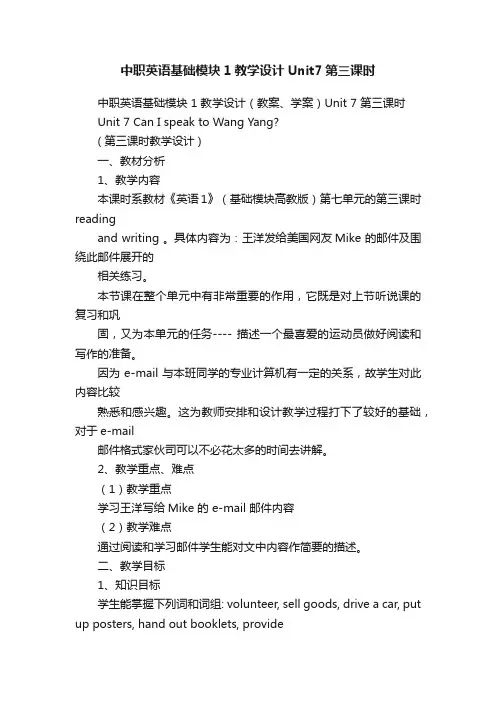
中职英语基础模块1教学设计Unit7第三课时中职英语基础模块 1 教学设计(教案、学案)Unit 7 第三课时Unit 7 Can I speak to Wang Yang?( 第三课时教学设计 )一、教材分析1、教学内容本课时系教材《英语1》(基础模块高教版)第七单元的第三课时readingand writing 。
具体内容为:王洋发给美国网友Mike 的邮件及围绕此邮件展开的相关练习。
本节课在整个单元中有非常重要的作用,它既是对上节听说课的复习和巩固,又为本单元的任务---- 描述一个最喜爱的运动员做好阅读和写作的准备。
因为 e-mail 与本班同学的专业计算机有一定的关系,故学生对此内容比较熟悉和感兴趣。
这为教师安排和设计教学过程打下了较好的基础,对于e-mail邮件格式家伙司可以不必花太多的时间去讲解。
2、教学重点、难点(1)教学重点学习王洋写给Mike 的 e-mail 邮件内容(2)教学难点通过阅读和学习邮件学生能对文中内容作简要的描述。
二、教学目标1、知识目标学生能掌握下列词和词组: volunteer, sell goods, drive a car, put up posters, hand out booklets, providesth. for sb., place flowers, be glad to do, more and more, look forward to2、能力目标习的练,解e-mail 的具体内容—担任奥运志愿者的工作,并通过具体活动完成课文相关通过阅读学生能理从而提高阅读和写作能力3、情感目标鼓励学生通过e-mail 的往来,加深彼此的了解和友谊三、教学步骤Step One Warm up 6 ’1. Teach new word “ volunteer ”Show a red cap of a volunteer.T: What ’ s this?S: ?T: If you wear this cap, what are you?S: ? .T: Do you work as an volunteer?S: ?T: What kind of work do you do as a volunteer?S: ? .T: Here are some work, can you match?2. Match the phrases and the picturesShow some pictures on the screen. They are about: sell goods, drive a car, put up posters, hand out booklets, play volleyball, play the piano and write e-mailWhen students are doing it, teacher asks them to tell the Chinese meaning.设计意图:学校里有青年志愿者服务队,通过志愿者小红帽的展示来学习单词volunteer 学生会觉得印象比较深;通过图片对e-mail 中的词组进行学习为课文学习做铺垫。


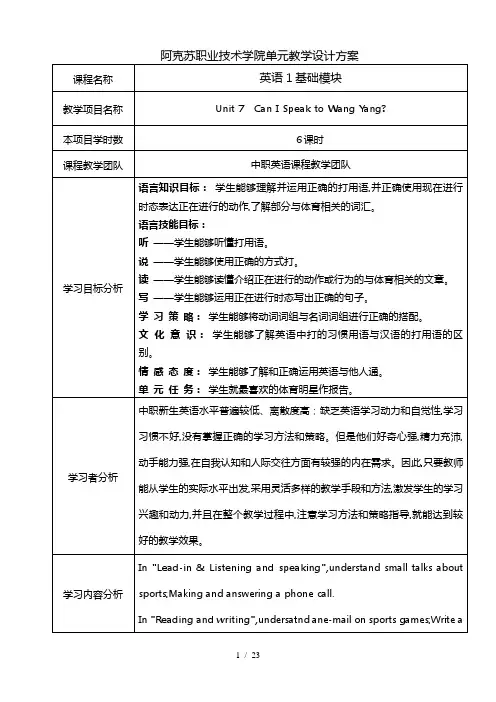
教学过程设计〔III 〔按照两课时的教学内容任务编写2. Create ten sentences with the simple present tense3. Finish self-check. 后 记:步骤 教学内容时间分配明确 任务Vocabulary Practice andUnit task 通过游戏复习本单元中出现的单词和词组以及词汇间的搭配使学生正确运用所学词汇,掌握音标/ts/, //, //, /η /以及相关的字母、字母组合。
完成单元任务。
5’项目 引导1.T: Now, let’s play a game. I’ll ask some of you to do actions. You can do the actions on the screen or you can do it by your own idea. When one of you are doing the action, each group please look and write down what he or she is doing on the paper which I hand out by group work. After ten of you finished the actions, we’ll check the answers. The group who writes down the most and the correct10’sentences is the best.2.lead-in the new class知识讲解⑴本单元关于打所涉及的关键句型及其运用情景,⑵能掌握音标/ts/, //, //, /η/以及相关的字母、字母组合。
⑶具备总结分析本单元关于打所涉及的句型功能及其运用情景的能力。
⑷学生能在日常交流中正确使用现在进行时。
⑸学生掌握正确的音标学习策略。
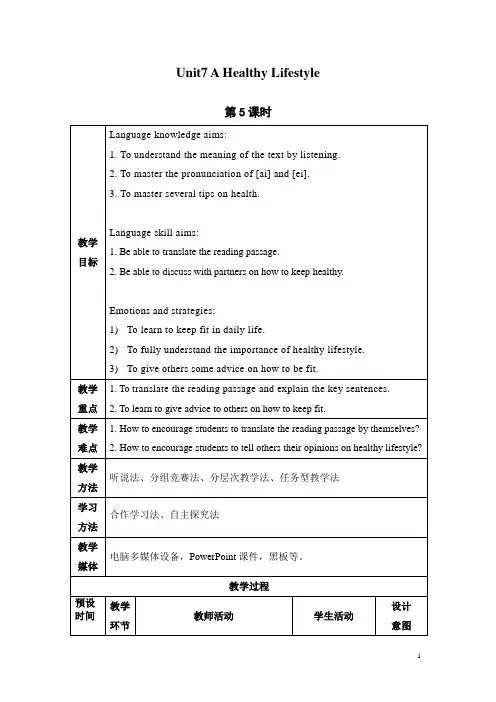
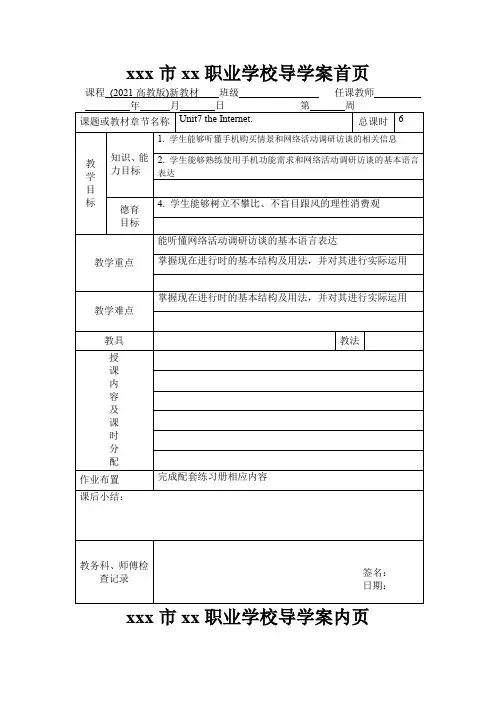
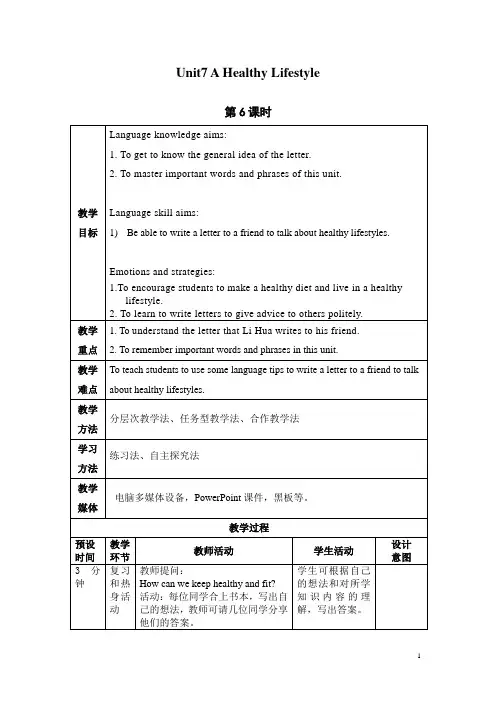
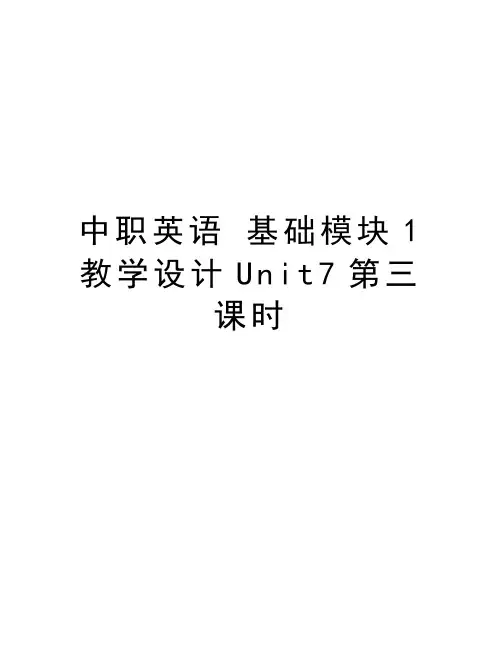
中职英语基础模块1教学设计U n i t7第三课时中职英语基础模块1 教学设计(教案、学案)Unit 7 第三课时Unit 7 Can I speak to Wang Yang?(第三课时教学设计)一、教材分析1、教学内容本课时系教材《英语1》(基础模块高教版)第七单元的第三课时reading and writing。
具体内容为:王洋发给美国网友Mike的邮件及围绕此邮件展开的相关练习。
本节课在整个单元中有非常重要的作用,它既是对上节听说课的复习和巩固,又为本单元的任务----描述一个最喜爱的运动员做好阅读和写作的准备。
因为e-mail与本班同学的专业计算机有一定的关系,故学生对此内容比较熟悉和感兴趣。
这为教师安排和设计教学过程打下了较好的基础,对于e-mail 邮件格式家伙司可以不必花太多的时间去讲解。
2、教学重点、难点(1)教学重点学习王洋写给Mike的e-mail 邮件内容(2)教学难点通过阅读和学习邮件学生能对文中内容作简要的描述。
二、教学目标1、知识目标学生能掌握下列词和词组: volunteer, sell goods, drive a car, put up posters, hand out booklets, provide sth. for sb., place flowers, be glad to do, more and more, look forward to2、能力目标通过阅读学生能理解e-mail的具体内容—担任奥运志愿者的工作,并通过具体活动完成课文相关的练习,从而提高阅读和写作能力3、情感目标鼓励学生通过e-mail的往来,加深彼此的了解和友谊三、教学步骤Step One Warm up 6’1. Teach new word “volunteer”Show a red cap of a volunteer.T: What’s this?S: …T: If you wear this cap, what are you?S:….T: Do you work as an volunteer?S:…T: What kind of work do you do as a volunteer?S: ….T: Here are some work, can you match?2. Match the phrases and the picturesShow some pictures on the screen. They are about: sell goods, drive a car, put up posters, hand out booklets, play volleyball, play the piano and write e-mailWhen students are doing it, teacher asks them to tell the Chinese meaning.设计意图:学校里有青年志愿者服务队,通过志愿者小红帽的展示来学习单词volunteer 学生会觉得印象比较深;通过图片对e-mail中的词组进行学习为课文学习做铺垫。

Unit 7 Can I speak to Wang Yang?(第一课时教学设计)一、学情分析本教案的授课对彖为高一年级计算机专业学生。
该班共有52名学生,其中女生10名。
本班同学思维活跃,兴趣广泛,热爱篮球、足球等体育活动。
有较强的计算机专业知识与操作技能。
但大多数同学尤其是男主英语入学基础比较薄弱,对英语缺乏兴趣和信心。
由于掌握的词汇量和句型结构少,造成人多数同学不敢开口说英语,课堂参与积极性和学习动机不强。
针对以上问题,本教案力求降低教学内容的难度,更多采川集体教学的方法增强学牛的自信和参与热情。
二、教材分析1.教学内容本课时系教材《英语1》(基础模块高教版)笫七单元的第一课时,包括lead-in & listening and speaking屮的Dialogue A两部分,具体内容为:运动图标与名称,打电话常用语句以及邀谙王阳一起打篮球的对话。
这些内容为整个单元的学习活动做语言和知识的准备,也为学生学以致用的语言表达活动提供了语言铺垫。
同时打电话的话题使教师可以充分地在教学中把教学内容与学牛的牛活联系起來。
2.教学重点、难点(1)教学重点通过学习打电话的对话,让学生掌握常用打电话语句。
(2)教学难点学牛记住关于运动项目的单词学生听懂有关打电话对话中的详细内容三、教学目标1.知识目标(1)学生能掌握部分运动项R 的名称,如volleyball, badminton, tennis, table tennis^, 及message 一词的丿IJ法。
(2)学生能掌握打电话时的常用句型:A: Hello! This is .... Can/May I speak to ....?B: Speaking・ / This is ..・ speaking. / ・・・.isn't in at the moment. Can /May I take a message? A: Ok, ....B: All right, Fll tell him / her.A: Thank you. Bye!2.能力目标(1)学生能听懂关于打电话邀请别人参加某一体育活动的对话(2)学生能根据常用打电话句型,打电话邀请别人参加某一体冇活动的对话练习3.情感目标学牛能懂得打电话的基本礼仪四、教学步娶Step One Lead in 6,1.Activity One ・■一Do you know the name of these spoils item?Show some pictures of different sports items on the screen.Then ask students to tell the English name of these items. If students can't, they are allowed to speak Chinese・(Since they haven^t learned some of these words and the vocabulary of them is poo 匚)Learn these words together with the help of pictures. Students are asked to read them one by one following the teache匚Then they can read them together or read them by themselves・Ask students to read these words one by one to check whether they can read or not.(设计意图:利用图片进行体育活动词汇的学习,可以帮助提高学生的兴趣和识记单词的有效性,同时此环节为后续环节增加必要的词汇量。
高教版中职英语基础模块1全套教案教案一:Unit 1 Introduction to English教学目标:1. 了解英语的起源和发展历程。
2. 学习英语的基本发音规则和语音特点。
3. 掌握英语的基本问候语和自我介绍的表达方式。
教学重点:1. 英语的起源和发展历程。
2. 英语的基本发音规则和语音特点。
3. 英语的基本问候语和自我介绍的表达方式。
教学难点:1. 英语的发音规则和语音特点的掌握。
2. 自然流利地运用英语的问候语和自我介绍。
教学准备:1. 多媒体设备。
2. 讲义和练习题。
教学过程:Step 1: Lead-in1. Greet the students and introduce the topic of the lesson.2. Show pictures of different countries and ask students if they know any English-speaking countries.3. Ask students why they think English is important.Step 2: Presentation1. Introduce the origin and development of English.2. Show a timeline of the major events in English history.3. Explain the basic pronunciation rules and phoneticfeatures of English.4. Use audio or video materials to demonstrate the correct pronunciation.Step 3: Practice1. Divide the class into pairs or small groups.2. Give students a list of common greetings and ask them to practice using them in different situations.3. Have students practice introducing themselves to each other using the phrases and sentences learned.Step 4: Consolidation1. Review the key points of the lesson, including theorigin and development of English, pronunciation rules, and greetings.2. Ask students to summarize what they have learned intheir own words.Step 5: Assessment1. Give students a short quiz to test their understanding of the lesson.2. Assign homework, such as writing a short paragraph about the importance of English or practicing greetings and self-introductions.教案二:Unit 2 Numbers and Time教学目标:1. 学习基本的数字和时间表达方式。
课题Unit7 The Internet(Grammar)课型Grammar课时2授课班级授课时间80mins授课教师教材分析本节课的主要内容为教材第七单元语言运用(Language Practice)板块,分为语法(Grammar)和词汇(V ocabulary)两部分, 主要学习现在进行时的基本用法和本单元的重点词汇。
课文提供例句,补全对话,操练对话等练习,学生可通过观察、对比、分析,归纳现在进行时的基本结构,巩固并掌握现在进行时的基本用法。
单元重点词汇来自本单元听力和阅读材料,教师可进一步讲解并组织学生在具体语境中运用单词及短语,检测并夯实所学内容。
学情分析学生在初中阶段已经学习了现在进行时的基本用法,大体掌握了现在进行时的概念和基本结构,看到“now”能够使用现在进行时。
但在实际的口语交际和书面写作中,学生容易遗漏或选择不符合人称或单复数的Be动词或者忘记使用动词ing形式,因此需要教师进一步系统且有重点地讲解。
对于词汇学习,教师要帮助学生掌握单词的正确发音,注意创设情景,帮助学生记忆单词,掌握单词的语用环境和使用方法,培养学生在真实情境中使用恰当的语言进行交际的能力。
学习目标Knowledge objectives:(1)To master the basic structure of the present progressive tense: am/is/are doing.(2)To be able to identify sentences with present progressive tense.Ability objective:To be able to use sentences with present progressive tense to say something and accurately express oneself.Emotional objective:To learn to relate English learning of present progressive with real life.学习重难点(1)To master the basic structure of the present progressive tense: am/is/are doing.(2)To be able to use sentences with present progressive tense to say something and accurately express oneself教学方法小组讨论法、任务教学法、情境教学法课前准备ppt课件,语音素材,视频与图片教学媒体PPT课件、多媒体设备、语音素材、拓展资源包等教学过程教学环节教师活动设计学生活动设计设计意图Step 1: Lead in Present a picture of eating the hamburger and askstudents:T: What is he doing?S: He is eating.Look at the pictureand answer thequestion: He iseating.通过图片的形式,自然引出现在完成时。
Unit 7 Can I speak to Wang Yang?Dialogue B I’m playing table tennisLearning objectives:1. Understand the sentences used to make a phone call.2. Master these sentence patterns.3. Make an own dialogue.Important points:Know how to make and answer a phone call.Difficult points:Students can remember all kinds of expressions for making a phone call.Teaching procedures:Step I. Warm up1. Make a duty report2. Review —— translate some sentences (competition)3.Check the answers——translationhold onmake a phone callall rightdo houseworkat the momentof courseStep II. Lead-inLook at some pictures,then describe them. Ask students “What are they doing?”Sara and Tang Hua are making a phone call in the last picture. What are they talking about? Please go into dialogue B.Step Ⅲ. Speaking1. Ask students to read the dialogue and answer the following questions:Q1: How many people are there in the dialogue?Three.Q2:What does Tang Hua want Sara to do ?Tang Hua wants Sara to play badminton with him.Q3:What is Sara doing?She is washing her clothes.2. Ask students to read the dialogue carefully and find out the sentences used to make a phone call.3. Translate the dialogue.4. Ask students to find out the key points and explain them.(1) May / Can I speak to Sara? Sara 在吗?(2) hold on 稍等(3) What’s up? 怎么了?与“What’s the matter? ”“What’s the problem?”意思相近(4) This is Tang Hua. 我是唐华。
实用标准文档文案大全Unit 7 Can I speak to Wang Yang?教学内容:Unit 7: Lead in; Listening and Speaking; Reading and Writing; Language in use语言知识目标:学生能够理解并运用正确的打电话用语,并正确使用现在进行时态表达正在进行的动作,了解部分与体育相关的词汇。
语言技能目标:听——学生能够听懂打电话用语。
说——学生能够使用正确的方式打电话。
读——学生能够读懂介绍正在进行的动作或行为的与体育相关的文章。
写——学生能够运用正在进行时态写出正确的句子。
学习策略:学生能够将动词词组与名词词组进行正确的搭配。
文化意识:学生能够了解英语中打电话的习惯用语与汉语的打电话用语的区别。
情感态度:学生能够了解和正确运用英语与他人通电话。
单元任务:学生就最喜欢的体育明星作报告。
Lesson One教学内容:Lead in; Listen and Speaking Dialogue A 教学目标:1知识目标:words and expressions; Making and answering a phone call 2 能力目标:Understand talks about sports. Describe actions教学重点:Understand an e-mail on sports games; Write a report on a famous player实用标准文档文案大全教学难点:Four-skill words and expressions 教学方法:启发式,互动式教学工具:教科书,收音机德育要点:学生能够了解和正确运用英语与他人通电话。
教学步骤:Step One: Presentation教师活动:Look and match. 看图,将下列北京奥运会的运动项目图标与项目名称搭配。
volleyball baseball badminton footballtabletennisbasketballswimmingStep 2 Lead in学生活动:Read and tick. 选出每组中更适合用于打电话的语句。
(1)( ) A. Hello! ( ) B. How do you do?(2)()A. Can I speak Ben Bush? ( ) B. I want to talk to Ben Bush.(3) ( ) A. Who are you? ( ) B. Who is that?(4) ( ) A. I am Ben Bush. ( ) B. This is Ben Bushspeaking. (5) ( ) A. Is that Ben Bush? ( ) B. Are you Ben Bush? Step 3 listening and speaking 教师活动:Can I speak to Wang Yang?学生活动: Listen and choose. 听录音,选择正确答案。
They will go to __________ restaurant. A Yueguang B Meiwei Listen and tick. 再听录音,选择正确的表述。
实用标准文档文案大全The phone call is between __________.a. Tang Hua and her fatherb. Tang Hua and Wang Yangc. Tang Hua and Wang Yang's father Listen and tick. 再听录音,勾出正确的便条。
From: Tang Hua Come to school this afternoon to play basketball. From: Tang Hua Come to school this afternoon to play football. From: Tang Hua Come to school tomorrow to play football. Read and underline. 阅读对话,用下画线标出打电话和接听电话的语句。
Wang Yang's mother: Hello!Ben: Hello! This is Ben. Can I speak to Wang Yang?Wang Yang's mother: This is his mother speaking. Wang Yang isn't in at the moment. May I take a message?Ben: OK, thanks. Please tell him to come to school this afternoon. I want to play basketball with him. Wang Yang's mother: All right. I'll tell him. Ben: Thank you. Good-bye!Wang Yang's mother: You're welcome. Bye!师生活动:Explain the language points: 重点词汇和句型This is Ben. 我是Ben。
英语中打电话用this 和that 来表示“我是?”和“你是?”。
Eg: Who's that? 你是谁? Is that Wang Yang? 你是王洋吗?实用标准文档文案大全This is his mother speaking. 直译为“这是他的妈妈在说话。
”在打电话时意为“我是他的妈妈。
” He isn't in at the moment. 他现在不在家。
in 在这里意为“在家”。
May I take a message? 可以捎个口信吗?take a message “捎口信”学生活动: Listen and repeat. 跟读对话,学说选出的语句。
Step 5 Sum(小结)板书设计: Unit 7 Can I speak to Wang Yang? Wang Yang's mother: Hello!Ben: Hello! This is Ben. Can I speak to Wang Yang?Wang Yang's mother: This is his mother speaking. Wang Yang isn't in at the moment. May I take a message?Ben: OK, thanks. Please tell him to come to school this afternoon. I want to play basketball with him. Wang Yang's mother: All right. I'll tell him. Ben: Thank you. Good-bye!Wang Yang's mother: You're welcome. Bye! Homework:(家庭作业)Recite the dialogue A. Feedback:(教学反馈)Lesson Two教学内容:Listen and Speaking Dialogue B实用标准文档文案大全教学目标:1知识目标:words and expressions; Making and answering a phone call 2 能力目标:Understand talks about sports. Describe actions教学重点:Understand an e-mail on sports games; Write a report on a famous player教学难点:Four-skill words and expressions 教学方法:启发式,互动式教学工具:教科书,收音机德育要点:学生能够了解和正确运用英语与他人通电话。
教学步骤:Step One: PresentationActivity 1:Ask students to Think and answer. 思考并回答下列问题。
Question 1: I'm playing table tennis. Step 2 Listen学生活动: Look and choose. 看图,选择动词的适当形式填空。
Ben __________ a phone call. A. makesB. is makingTang Hua __________ housework. A. doingB. is doingLi Xiaonian and Zhang Qing __________ badminton. A. are playing B. playListen and judge. 听录音,判断下列图片和表述是否正确。
( ) a. Ben is making a phone call with Sara. ( ) b. Wang Yang is making a phone call with Sara. ( ) c. Ben is doing housework.实用标准文档文案大全( ) d. Sara is doing housework.( ) e. Ben and Sara are playing table tennis. ( ) f. Ben and Wang Yang are playing table tennis.Read and underline. 阅读对话,用下画线标出打电话和接听电话的语句。
Tang Hua: Hello! This is Tang Hua. May I speak to Sara? Sara's roommate: Hold on, please.A moment later. Sara: Hello! This is Sara speaking.Tang Hua: Hi, Sara. This is Tang Hua. What are you doing now? Sara: I'm washing my clothes. What's up?Tang Hua: I'm playing badminton with Xiaonian at school. Sara: Oh!I like playing badminton best. Tang Hua: Would you like to join us? Sara: Of course! I'll come soon! Tang Hua: Good! See you!教师活动:Explain some key points:May / Can I speak to Sara? Sara 在吗?Hold on, please. 请稍等。